Aquarium
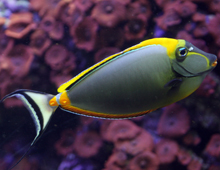
Blond naso tang, Naso elegans
Also known as the Elegant tang, or Indian orangespine unicornfish, the Blond naso is a member of the surgeonfish family. Two bright orange spines can be seen extending from the base of the tail. These spines are said to be “as sharp as a surgeon’s scalpel”, hence the name surgeonfish. This species was once thought to be a different color variety of the Lipstick tang, Naso lituratus, but is now considered its own species. The Blond naso is primarily a herbivore and can be found in coral reefs throughout the Indian Ocean and the Red Sea.
LEARN MORE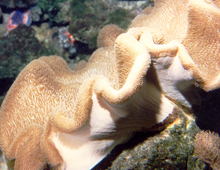
Leather coral, Sarcophyton spp.
Named for their appearance, which can resemble a baseball glove, the Leather coral, or Toadstool coral is found in various shades of brown, green, or yellow with white or gold polyps. It can be difficult to identify leather corals because many of them are similar in appearance. As they grow older, they develop a folded appearance. Like other soft corals, Leather corals incorporate tiny, single celled algae, known as zooxanthellae in their tissues.
LEARN MORE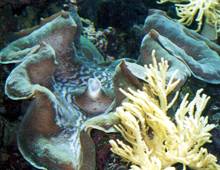
Giant clams, Tridacna gigas
Tridacna gigas is the largest of the giant clam species, reaching more than 59 inches across in length and weighing more than 550 pounds. It is found on coral reefs throughout the Indo-Pacific, but may have become extinct in large parts of its former range. The adductor muscle of these clams is considered a delicacy in some areas, which has led to its overexploitation. Giant clams filter in microscopic plants and animals known as phytoplankton and zooplankton. Single celled phytoplankton, known as zooxanthellae, are photosynthetic and grow within the tissues of the clam providing it with nutrients and oxygen. For this reason, Giant clams are dependent upon light for survival.
LEARN MORE
Green star polyps, Pachyclavularia violacea
The Green star polyp is a hardy colonial invertebrate commonly kept in aquariums. Its characteristic bright green star-shaped polyps seem to glow in the sunlight. These tiny filter feeders can absorb organics from the water column, and like other corals, the polyps of this species also house zooxanthellae, photosynthetic algae cells which provide the coral with nutrients. A purple mat of tissue, known as a stolon, connects the multiple polyps, often covering the rock beneath it.
LEARN MORE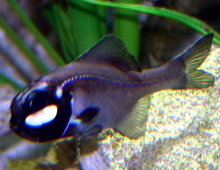
Flashlightfish, Photoblepharon palpebratus
What may look like glowing eyes are actually organs beneath each eye that are inhabited by symbiotic bioluminescent bacteria. There are eight species of Flashlightfish found in warm seas around the world. Like their relatives, the Orange roughy and the squirrelfish, they are nocturnal animals that retreat to caves beneath reefs in the daytime, and hunt for small animals in shallower water at night.
LEARN MORE
Moon jellyfish, Aurelia aurita
This type of jellyfish is often cultured around the world. Their sting is not powerful because they are planktivores. The flower-like pattern in the center of the disk is composed of the reproductive organs; reproduction is both sexually and asexually. This delicate invertebrate is known to survive for only a few months in the wild, but can live for years in an aquarium environment.
LEARN MORE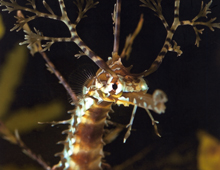
Ribboned seadragon, Haliichthys taeniophorus
The Ribbon seadragon, more accurately described as a pipehorse, is a close relative of the seahorses and pipefish. Depicted as the “Rainbow serpent” in the Aboriginal rock art of Arnhem Land, the Ribbon seadragon was believed to have special powers. In 2006, The DWA became the first aquarium in the world to successfully breed this relatively unknown species. Like other Syngnathids, the Ribbon seadragon feeds on very small shrimp known as mysid shrimp. Unlike their cousins the Leafy (Phycodurus eques) and Weedy seadragons (Phyllopteryx taeniolatus), the male Ribbon seadragon possesses a pouch and can give birth to more than 800 fully developed offspring at a time.
LEARN MORE
Mandarin dragonet, Synchiropus splendidus
The Mandarin dragonet is sometimes called the Psychedelic fish because of its flamboyant coloration which resembles the robe of an Imperial Chinese officer. It is an extremely popular aquarium fish known for its intricate mating displays. Mandarin dragonets feed on small crustaceans found in the sediment and crevices of rock and corals. Their natural range includes the Western Pacific, Indonesia the Philippines and Australia.
LEARN MORE
Striped shrimpfish, Aeoliscus strigatus
The Striped shrimpfish, or Razorfish, is an unusual fish that is a distant relative of the seahorses and pipefish. Its slender, flattened body allows it to hide amongst the branches of corals or spines of a sea urchin. It swims “upside down” in synchronized schools and feeds on tiny zooplankton. The Striped shrimpfish inhabits shallow coral reefs throughout the Indo-West Pacific.
LEARN MORE
Copperband butterflyfish, Chelmon rostratus
The Copperband or Beaked butterfly fish is a popular species, but can be a finicky aquarium inhabitant. By nature, the Copperband butterfly feeds on coral polyps, its long slender mouth perfectly suited for this task. In aquariums, the Copperband butterfly is often introduced as a “natural” pest control solution for nuisance anemones such as Aiptasia spp. The dark spot near back half of the dorsal fin is believed to be a “false eyespot” which can fool would-be predators into thinking the fish’s eye is on the opposite end, giving the fish a chance of escape.
LEARN MORE

